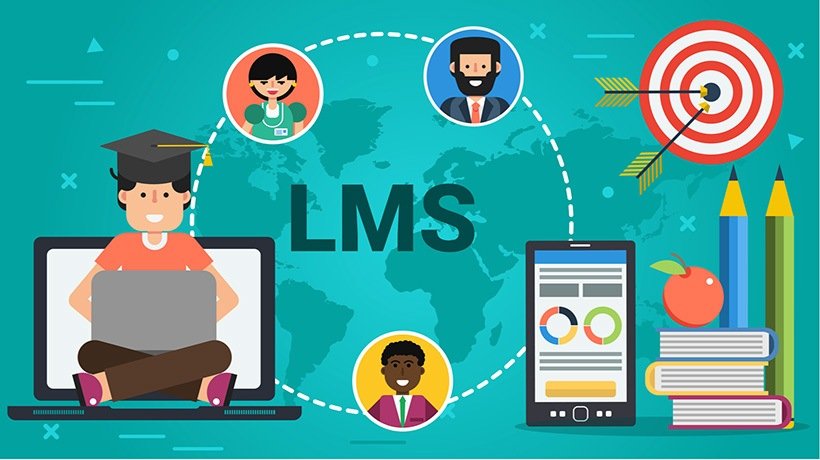Even though online classes are becoming increasingly popular, many individuals are still unclear about a Learning Management System.
This learning management system overview thoroughly examines the programme, its advantages, well-liked components and suggestions on how to pick the best one for your company.
Although you might already be familiar with learning management systems, this blog may be useful if you are new to eLearning or are still unsure whether an LMS system is the best choice for your online teaching endeavour. As the demand for eLearning increased, the concept of a “Learning Management System” appeared. Because COVID-19 offers an alternative to in-person training, the use of LMS has recently increased dramatically.
Learning Management Systems: What is it?
A learning management system is software that serves as a hosting platform for online courses. The LMS platform was created to emphasise on online learning and teaching as a virtual meeting place with all the tools teachers and students require. The platform also serves as a management system by assisting instructors in planning their online courses (creating them, changing them, assigning them to students and classifying them).
A learning management system is the best online platform for instruction and learning. Businesses and educational institutions can access many training and instructional resources through cloud-based technologies. Usability is one of a learning management system’s key features. Another is the range of customisation possibilities it offers. The LMS platform enhances your course content, improving online learning management’s adaptability, legitimacy and scalability. The LMS also consists of workforce training software, learning activity management and learning experience platform systems.
Two Main Categories of LMS Participants
By making these two vital tasks simpler, the finest learning management systems should support an organisation’s training initiatives:
- A server that enables L&D professionals to carry out three essential functions:
- Developing;
- Managing and delivering courses; and
- Other eLearning materials.
These servers are a central repository for crucial information regarding a learner’s success and growth.
- A user interface that administrators, teachers and students use: This user interface is simple, easily accessible and operates inside a browser or app.
What is the Purpose of a Learning Management System?
While adopting an LMS has several advantages, including cost savings and increased security, its primary function is to deliver and monitor learning and eLearning efforts in one location. Depending on the goals of the firm, an LMS will look and function differently, but its features should enable L&D professionals to streamline the following procedures:
- Registration and delivery of courses
- Monitoring and studying user data
- Performance-based tasks, such as skill gap analysis
- Administration of courses
- Interaction between instructor and learner
Learning professionals can use specific data items to confirm that individual students are attaining the necessary learning objectives, which is another advantage that links to the goal of an LMS. Every instructor knows that students in both conventional and online courses will experience a variety of successes and setbacks.
What are the Benefits of Employing a Learning Management System?
A programme designed specifically to train and transfer students’ knowledge successfully is a learning management software platform. A trustworthy LMS that digitally tracks and engages student activity is the quickest and easiest way to put learners in a rhythmic flow.
With the aid of an LMS, a company can keep all of its learning and development resources in one easily accessible spot. In addition, you can save, sort, edit and discard data without navigating outside of the app. Multiple people can work on the content simultaneously, and courses can be updated over time to reflect the most recent information.
People are now becoming more interested in learning management systems as a result. The online software allows companies and academic institutions to track, monitor, report on and document the delivery of educational courses. Because of LMS, access to educational resources and information has completely transformed. An LMS is an excellent tool if you work for a large organisation that frequently hires contract workers, and you need to give them continual training. An LMS may result in increased productivity for these firms.
Students with access to workforce training software can examine their course catalogue, complete any necessary examinations and keep tabs on their personal development. Learning management systems that are most successful give students immediate access to their courses and other resources with a streamlined user experience. Training can be provided to certain individuals or groups of employees depending on their organisational rank and job assignments.
Components of a Learning Management System
Finding two LMSs with the same features among the available hundreds would be difficult. There is no definitive list of elements that define what a learning management system is and isn’t. Even though a specific set of operations is conventional, the LMS’s entire capabilities will vary based on the firm and intended application.
An LMS often possesses the following components:
Meeting Industry Requirements for eLearning
Data exchange with different eLearning platforms is made possible by compliance with eLearning standards like SCORM and TinCan. The industry-standard TinCan/SCORM protocols let you import eLearning content made on any compatible platform. A marketplace for eLearning materials that comply with SCORM standards gives you access to hundreds of highly competent courses on various business-related subjects.
Distribution Over Multiple Channels
Multi-channel learning is learning that takes place through in-person and online channels. Student accounts and course materials must be accessible from any medium, including desktop computers, tablets and mobile phones. However, the greatest learning management system might be available online without particular software or an app.
Course Administration, Development and Import
Administrators should have access to a built-in course builder and the option to import course materials from other platforms. The ability to transform pre-existing text or slide files into courseware-ready content should be available to administrators.
Management of Documents
Managing and uploading documents is important for both students and teachers. Anything related to the curriculum, including readings and homework, may be collected in these files.
Course Calendars
It offers tools for setting up and sharing class schedules, due dates and test dates. These calendars aid students in keeping tabs on their progress through the programme.
Social Features
Student participation and knowledge sharing are encouraged through notifications, messaging and discussion forums. Learner engagement and course completion rates can both be improved by well-designed social components.
Tracking and Reporting
Administrators and students should be able to check test result records since comprehensive reports are provided. Administrators should also be able to generate and provide detailed statistics and information on the general performance of students. Users can track their progress and determine how well they are doing in their courses with the use of the information that is accessible.
Certification and Assessment
Pre-course evaluations, typically diagnostic tests, use an LMS to assess employee knowledge levels and provide the appropriate material. It is also important to provide both physical and digital certification.
Who utilises LMS software?
Since the advent of eLearning, the use of LMS has become more widespread. Additionally, the intended audience demographic is now more diverse than ever. According to research, any field that uses remote learning eventually turns into an LMS.
The intended industries for the LMS are categorised as follows:
- Software Industry: These businesses may connect learners by overcoming demographic and regional obstacles with an efficient LMS platform.
- Healthcare Industry: A never-ending supply of medical professionals must be trained to use essential tools and procedures, with medical settings being the most active ones. Since most of these training sessions are repetitious, these practitioners must access a well-organised learning management system.
- Biotechnology and Pharmaceuticals: The Biotech and Pharmaceutical experts require a suitable LMS to keep up with the ongoing changes in pharmaceutical items’ technology, procedures and distribution techniques.
- Advertising and Marketing Services: Online marketers and advertising professionals need to keep up with the rapidly evolving global market. A learning management system created for them can help them gain the skills they need even from the comfort of their homes.
Learning Management Software Services: Getting Started with the Professionals!
Learning management systems have revolutionised education and serve as the foundation of any eLearning initiative within a company. One should carefully select or create this backbone to ensure it functions best for the companies and learners. If you want to choose among the options available, pick a learning management system that is adaptable, simple to use and scales with your company. If not, seek assistance from a qualified web development partner to create a unique LMS.
An in-depth evaluation of each LMS’s features and advantages is necessary. This choice is challenging because it calls for a lengthy commitment. Select an LMS that is designed with the future in mind. After reading the product description and learning more about the business and its plans, this should be clear. Obtain information from client endorsements and distinctions the business has won.
You should be able to choose and justify investing in a reliable learning management system for your firm’s requirements using the information provided above.













